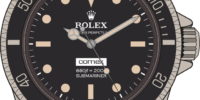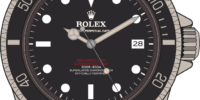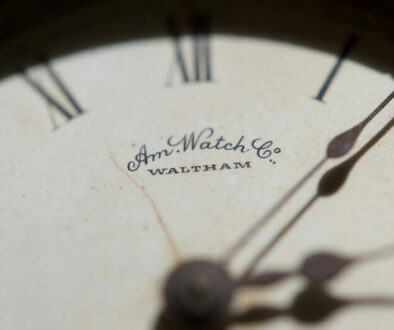An introduction to the history and identification of the Rolex Sea-Dweller and its different models.
The history of the Rolex Sea-Dweller
The Sea-Dweller is not the most popular Rolex watch, especially when you consider the likes of the Datejust, Day-Date and the Submariner. However, the Sea-Dweller, earnest in its beginnings in a niche market of saturation divers, has become increasingly sought after and revered in the world of vintage sports watches.
Rolex are not averse to creating timepieces for a niche market, in fact it seems quite the opposite; Rolex enjoy creating watches with purpose and the more technical and subject-specific the better.
Historically Rolex have created watches for medical professionals, designed with ‘dead seconds’ which meant that it ticked loudly, like a traditional quartz watch. It was especially popular with doctors, who used it to check pulse rates. Another unusual commission was the Rolex Milgauss, with its anti-magnetic qualities (read more about the Milgaus watch here). These watches offered unique and specific features, but sadly their niche qualities and relatively small target audiences meant they were both discontinued.
This was not the case with the Sea-Dweller. Despite its humble beginnings as a commission from the saturation diving industry, the Sea-Dweller withstood the test of time and has become a coveted collector’s item. There were eight models produced and all of them are sought-after by collectors.
Rolex 5513s/ 5514 – The Comex editions
A prototype of the Sea Dweller was first born in 1967. It was designed specifically for saturation diving, after a group of French commercial divers (Comex) found the Submariner 5513 was not compatible with their new diving technique. During saturation diving the group found that over time helium molecules were getting into the gaskets of the watch and the pressure change following decompression was forcing the crystal away from the watch itself.
Rolex were more than happy to develop a solution for Comex. Rolex created and installed a one-way pressure relief valve on the side of the watch case. These values were initially fitted to the submariner models, and selected editions of these were released for Comex. These models 5513 have a unique ID number on the back and later editions had Comex logo engraved on the back.
Subsequent orders of this watch by Comex were given a specific model code; 5514. This was a very limited release and the models had the Comex label on the dial. These 5514 are highly desirable to collectors.
The moniker ‘Sea-Dweller’ began as a nickname, owing to the amount of time that the watch spent underwater, over time it stuck, and Rolex continued with it as the official title.
The Sea-Dweller 1665 edition 1, aka the Double Red Sea-Dweller
Model 1665 was the first official production of the Sea-Dweller known the Double Red Sea-Dweller and was released to the public in 1967. The name refers to the two line of red text that features on the dial, which differs from the single line on other models.
As the Sea-Dweller was based on the Submariner they share a lot of features on first glance. The simplest way to differentiate between the Double Red Sea-Dweller and Submariners (apart from the text) is the valve on the left side. It also has a date display on the right side of the face, this was an important feature for saturation diving due to the length of time the divers had to spend under water. The Sea-Dweller did not feature the usual ‘cyclops’ over the date window that other models with date wheels have, this is because the cyclopses were usually glued on and they couldn’t stand the pressure of the deep-sea diving. Instead the Double Red Sea-Dweller featured a thick domed plexiglass, which has proven popular with collectors.
There are multiple dials for the Double Red Sea-Dweller, which seem to tally with different versions of the red text. These dials are classified from Mark 0 to Mark 4, however, there are some newer editions that were brought in more recently by Rolex; with Mark 5, 6, and 7, which were replacement dials, rather than the originals. Generally speaking the earlier the configuration, the more valuable the watch as these editions are more highly prized by collectors.
- Sea-Dweller 1665 - Great White Sea-Dweller
Sea-Dweller 1665 edition 2, aka \’Great White\’
Like its predecessor the nickname of the Sea-Dweller 1665 second edition comes from the colour of the text on the dial; changed to white for this release (of course there is also the shark reference which was likely intentional). There is a distinction between the first Mark 0 configuration, and later Marks 1- 4. The most collectable of the Sea-Dweller Great Whites is the Mark 2, owing to a distinctive line of text that refers to the Chronometer. The alignment of text is referred to as a \”rail\” which is a common feature of the Comex specific dials, making them quite rare and highly desirable, especially among collectors.
Except for the Comex versions, the market value of the Great White models is much less than a Double Red Sea-Dweller models. However, the Great White was the very last Sea-Dweller to feature a plexiglass crystal, which is a crucial factor considered by purchasers of vintage watches to add value. The Great White Sea-Dwellers are therefore still highly collectable.
- Sea-Dweller 16660 - Triple 6 Sea-Dweller
Sea-Dweller 16660, aka \’Triple Six\’
The Triple 6 takes its name not from any satanic reference, but from the digits in its model number. This model was the first real deviation from the original 1665 and was the start of a move towards a more modern style. The Tripple 6 features a sapphire crystal and is one of the first Rolex designs to do so. Not only was it an attractive addition, but it also offered the Triple 6 an increased water resistance of up to 4,000 feet/1,220 meters – twice the previous models.
Additional changes included an alteration to the date disc, which became off-white instead of silver, the bezel became unidirectional, and the pressure release valve grew. There were two different types of Triple 6; the earlier models favoured a matte dial and later editions had a glossy dial with a white-gold surround. This is important to consider when looking to purchase a vintage watch, as the matte dial with painted indexes are more highly sought-after.
A Sea-Dweller 16660 is generally less valuable than a Great White, however, it is worth noting that a matte 16660 is worth more than the glossy.
Sea-Dweller 16600
First released in 1989, the 16600 is almost exactly the same as the Triple Six; it kept the sapphire crystal and has the same water resistance. What is interesting about the 16600 is the changes to its luminous material, which is evident from the dial; what began as tritium later changed to Luminova, and again later to SuperLuminova. To identify which is which you need to look for either T Swiss T<25 for Tritium, Swiss for Luminova, and Swiss Made means it is a SuperLuminova; this is a simple way to check the age of your 16600.
This model also uses the calibre 3135 movement, an improved version of the calibre 3035. The 3135 is one of Rolex’s most celebrated movements because of its reliability and durability; it also incorporates a perpetual winding system. However, after 20 years on the market, the 16600 was discontinued in 2009.
The long period of availability is important when valuing your 16600, as it means that they are not difficult to come by. To get the most value from the Sea-Dweller 16600 you should present it with its original box and papers; a watch on its own will be worth considerably less.
Modern Sea-Dweller models
The Sea-Dweller 116660
A relatively modern release, the 116660 first entered the Rolex catalogue in 2008, the main selling point of this watch was its water resistance, which had increased to an impressive 12,800 feet; triple that of the Sea-Dweller 16600. Rolex achieved these new depths by engineering a 5mm sapphire crystal to support the underwater pressure. They also upgraded the bezel with Cerachrom and the new Chromalight lume, which made it more visible in murkier waters; a necessity in deep-sea diving. With a 44mm case, this model required a titanium case back to help manage the weight of its upgraded mod-cons. The result was a marvel of engineering and style that blew other diving watches out of the water.
Rolex unveiled the D-Blue special edition in 2014 to commemorate James Cameron\’s 2012 expedition into the Marianas Trench. Although it is a commemorative edition, it was not a limited edition and is still currently available for purchase, therefore it does not have as much value as a vintage or pre-owned piece as some others. What is also noteworthy about this watch, is the staggering depths it reached on Cameron’s Trench expedition; whilst attached to the side of the vessel the watch travelled to a depth of 10,908 meters (with a 51mm case).
The Sea-Dweller 116600
The Sea-Dweller returned in 2014 after a five-year hiatus, in the form of the 116600. The latest edition came with a Cerachrom bezel upgrade to Cerachrom ceramic and the case was reduced back to 40mm. Sea-Dweller 116600 was a dream model for vintage enthusiasts with its Maxi dial, large indices and full minute markings on the bezel. It also has the superior Chromalight lume in blue, plus a updated clasp.
This model is the shortest-lived Sea-Dweller in Rolex’s history, largely because its cost was comparable to the Submariner, with which it struggled to compete. However, the limited timeframe of its availability and its removal from the market has of course increased its value.
The current Sea-Dweller 126600
When the 12600 arrived in 2017 there was much ado about the latest addition to the design; a cyclops over the date wheel. This was the first Sea-Dweller to adopt the cyclops, which made it an exciting release from Rolex. Not wanting to deviate too far from the original Sea-Dweller models, Rolex retained the single red line of text, making this watch a charming juxtaposition of vintage and modern.
This edition has also grown, now at 43mm, setting it further apart from its predecessor and some-time competion the Submariner, which has never been more than 40mm. The lug size also grew to 22mm, which helped maintain its proportion. The 126600 also saw an upgrade from the earlier calibre 3135 to the 3235, which offers a longer power reserve, greater magnetic resistance and precision.
The modern 126600 Sea-Dweller was specifically designed to bring the Sea-Dweller away from the Submariner. It is designed to set it apart from the Submariner and offer a lighter weight, more aesthetically pleasing option that could withstand the test of time, and depth.
What makes a highly collectable Sea-Dweller?”
What makes a collectable Sea-Dweller? There are several factors to consider, the main features being:
- Double signatures
- Special orders
- Age
- Provenance
Double signatures
The best-known and often highly sought after, double signature Sea-Dwellers are from Tiffany & Co, not least because they are incredibly rare. As you can imagine not many New Yorkers had need for a watch that could descend the Marianas Trench, which means that relatively few Sea-Dwellers were sold from Tiffany & Co. Furthermore, the addition of the Tiffany signature meant that the Sea-Dweller had more text on its dial than any other sports Rolex in existence; an unusually popular idiosyncrasy in the design; one that makes it a coveted piece for any collector.
It is worth noting, however, that due to their rarity, double-signed Sea-Dwellers are prime targets for fakes, so make sure you take care with any purchase of one of these. As always, the best advice is to ensure paperwork is available and can be verified.
Special Orders
There are also some extremely collectable Omani Sea-Dwellers, which were customised for members of the Omani Royal Family. The Omani editions have far less text than the Tiffany watches, instead have the national emblem of Oman on the dial; only 90 of these were ever produced. One of the 90 was sold May 2015 for over £305,000.
Age & Provenance
As with most collectable items, when it comes to the Rolex Sea-Dweller, the older your Rolex is, the more sought-after it is, and the more valuable it becomes. In addition, if a watch has a good story to tell, then that adds further value. Of course, it is necessary to have proof of the watch’s provenance; it is no good just saying that your timepiece has been to the bottom of the Atacama Trench, we need a selfie with a lantern fish to prove it – or at least, you get the idea – the more original photographs, dive logs, and general evidence, the better.
The Single Red Sea-Dweller
The pinnacle of collectable Sea-Dweller’s is the Single Red. No model will excite a collector more than a Single Red. The Single Red Sea-Dweller is the rarest of the Sea-Dwellers and will see collectors coming out of the woodwork for the merest look. In 2012, a Single Red Sea-Dweller sold for just under £400,000.
If you would like to know more about valuing or selling your Rolex Sea-Dweller please get in touch. You can send us an email to [email protected] and one of the team will be happy to answer your questions.
















